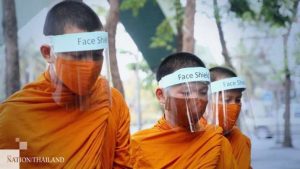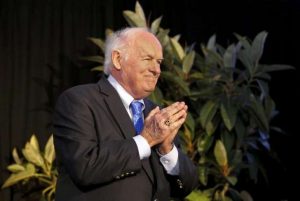
The path of liberation can be seen in terms of two approaches: the gradual path of the Sutra teachings and the resultant path of the Mantra Vajrayana teachings. In the Sutra approach, we purify confusion and gradually uncover wisdom; in the Vajrayana, the practitioner takes that innate wisdom as the path. This first of four bimonthly articles discusses the foundation of Buddhism, and how the view and practice of the Sutra teachings naturally serve as the foundation of the Vajrayana. Neither an academic analysis nor an actual Vajrayana teaching, this series aspires to clarify the Mantra teaching as we encounter it as laypersons in a modern context.
The Foundation of Buddhism
The premise for Buddhism is the potential all life has for awakening, and the empirical fact that we can experience more or less confusion, more or less happiness. We observe how our positive and negative states of mind don’t just happen randomly, but happen due to causes and conditions. With less confusion we feel more at home in our reality, more awake, more at ease with our world.
The Buddha taught that we are in a position to do something about these causes and conditions, yet, the premise is the abiding unchanging reality of enlightenment, our true abiding nature, referred to as Buddha nature. The Sutra path approaches the path through working with the immediate reality of our ordinary confused mind; the Mantra path approaches it with the recognition of the innate abiding reality of the timeless wisdom of Buddha nature.
Although the Buddhist understanding of consciousness extends beyond the scope of contemporary psychology or neuroscience, it still operates within familiar parameters of human experience. The discussion of the practice of the path also does not extend beyond a rational and recognizable dimension of human potential.
The Buddha’s first teaching, on the Four Noble Truths, recognizes the observable fact that while every one of our actions is based on a desire for happiness and pleasure, the truth is that we fail in our objective; the first Noble Truth is that we suffer.
The second Noble Truth is to identify the cause of suffering. According to the Buddha’s teaching, suffering is not inflicted upon us by some higher power, nor is it inevitable in a meaningless universe of random chaos. The second Noble Truth is that our suffering is caused; our suffering is due to a confused consciousness that mistakenly conceives of a self that, when investigated, doesn’t actually exist.
The Buddha discovered that confusion and suffering are not basic to us. We are not trapped in our delusion. The Buddha discovered the cessation of suffering, which is the third Noble Truth. He discovered freedom from the conceptual constructs that rule our consciousness.
The fourth Noble Truth is the Buddha’s prescription for how to practically address this condition of confusion. Nobody can save us, but we can apply practical measures to address the cause of suffering. The Buddha taught a remedial path of ethical action, of training the mind through meditation, through which wisdom emerges. Hence the Buddha empowered the individual, and taught how any person can attain the same freedom and awakening.
These Four Noble Truths are basic to all Buddhist teachings and paths. In these four truths, we can see that the Buddha did not introduce any mystical or metaphysical assumptions. His teaching never extended beyond the familiar pragmatism of remedying a problem.
It is not just contemporary people who appreciate such pragmatism. Assaji, one of the Buddha’s disciples, defined the Buddha’s teaching as follows:
All phenomena originate from causes; these causes were explained by the Tathagata [the Buddha]. The cessation of these causes was also explained by the Great Renunciant.*
No-self and Bodhichitta
The delusion of self is never an essential reality: self is a non-essential construct that arises from ignorance, on the basis of non-essential causes. This condition, known as samsara, is extensively described in the teachings on the Twelve Links of Dependent Arising (Pratityasamutpada). As long as we suffer from this delusion, we continue to wander in the cycle of rebirths.
The Buddha taught that if we investigate, we will find no absolute self, neither in the subjective aggregations that we refer to as our “self,” nor in the objective aggregations of outer phenomena that we refer to as “other.” This does not mean there is no functioning person or phenomena, but it means that if we investigate, we will not find any absolute essence. The Buddha encouraged us to look, because it is this blind assumption that is our downfall.
Through mindfulness, or shamatha, meditation, the practitioner discovers the wider perspective of selflessness—vipashyana—and continues to gradually enhance this experience in ordinary life. Selflessness, or emptiness, is not an otherworldly experience, but a very real sense of presence, of relinquishing fixation on mental content, and providing wider perspective. With such vipashyana, the practitioner ceases to define his or her outlook in terms of self. This ultimately leads to freedom from the conceptual constructions of the ordinary mind (nishprapanca) and the realization of complete awakening.
The sage’s vision of selflessness leads to renunciation of a private nirvana, and a corresponding vow to assist all sentient beings and liberate them from suffering, which is known as the bodhisattva vow. Such a vow ensures that wisdom doesn’t fall into self-absorption, and also ensures that compassion doesn’t become a personal project. A sage possessing wisdom devoid of warmth would be pitiful, as would a sage possessing love and compassion, yet with the dualistic strings of expectation.
This vision of awakening is called “bodhichitta”—a mind or heart of awakening—and is the core of the bodhisattva’s spirituality; it informs a greater vipashyana, and a greater courage and commitment to the world. Bodhichitta is the heart of the Mahayana path.
We might not be sages ourselves, yet we can appreciate the magnanimous qualities of the bodhisattva. This appreciation reflects a corresponding nature within ourselves—that we have the pure DNA that resonates with wisdom and compassion. This purity is innate to all life as the abiding ground of reality, and to realize this purity is the difference between ordinary sentient beings and a Buddha. All life has basic purity, while Buddhas have the additional purity of awakening.
Sutra and Mantra Perspectives
In the Sutra path, this two-fold purity is realized gradually. Delusion is eliminated gradually through the practice of the path, in which realization of wisdom and compassion dawns gradually. The Mantra view sees the same reality from a “glass-full” perspective: as much as we might be neurotic and suffering beings, innately we are Buddhas. Otherwise why practice the path? Unless the condition is curable, why treat it? The good news the Buddha had for us is that our delusional condition is very curable indeed.
While both the paths of the Sutra and Mantra are based on our humble recognition that we are indeed confused and suffering individuals, the Mantra Vajrayana approach banks on the undeniable fact that, being curable patients, we are in reality in possession of the same healthy disposition as the physician, the Buddha. So while this physician prescribes a gradual treatment, the implication is that he or she is empowering our innate untarnished potential to be just as it is.
As the practitioner travels the Mantra path, confusion is purified, giving way to the vipashyana that sees the abiding innate ground of wisdom. Here mind is no longer seen as entirely a confused subjectivity, but rather is seen as a deity, with the world around seen as a pure realm. This is the dawning of sacred reality, also called pure perception, which is the scope of the Vajrayana yogi.
We may temporarily perceive and construct ourselves and others in terms of our delusion and our confused projections, yet the truth is that these constructions are merely temporary fleeting conditions. As it says in the Hevajra Tantra:
Sentient beings are Buddhas;
Temporarily obscured as they might be by fleeting stains,
When these stains are eliminated, they are actual Buddhas.
We are not dreaming up some new reality. We are embracing reality as it is, and this is why even in our obscured state we are presently able to recognize and value wisdom and compassion. While both the gradual and resultant vehicles consist of gradually eliminating obscurations and their causes, and gradually realizing our potential, the resultant Vajrayana path acknowledges our true nature as the ground of our journey. We might perceive ourselves as ordinary beings, but we travel the path with an empowered perspective of our true worth.
*Ye dharma hetuprabhava hetum tesham tathagato hyavadat tesham ca yo nirodha evamvadi mahashramanah. The value of this statement is reflected by the fact that in Buddhist ceremonies, this is chanted as an auspicious invocation of the power of truth.
This article aspires to give some sense of the foundation of Vajrayana. The next will look at how this path practically unfolds.
Jakob Leschly is Resident Teacher for Siddhartha’s Intent Australia. He is a student of the late Dilgo Khyentse Rinpoche, as well as Dzongsar Jamyang Khyentse Rinpoche.
Starting on 2 July, Jakob will be offering online studies on Shechen Gyaltsap’s essential Mahayana instruction “The Great Medicine,” and from 15 October, studies on Dilgo Khyentse Rinpoche teaching on Padampa Sangye’s “Hundred Verses of Advice.” These one-hour studies will each run over six Thursdays from 6.30 p.m. (Sydney time). For further information, see Siddhartha’s Intent Australia.






